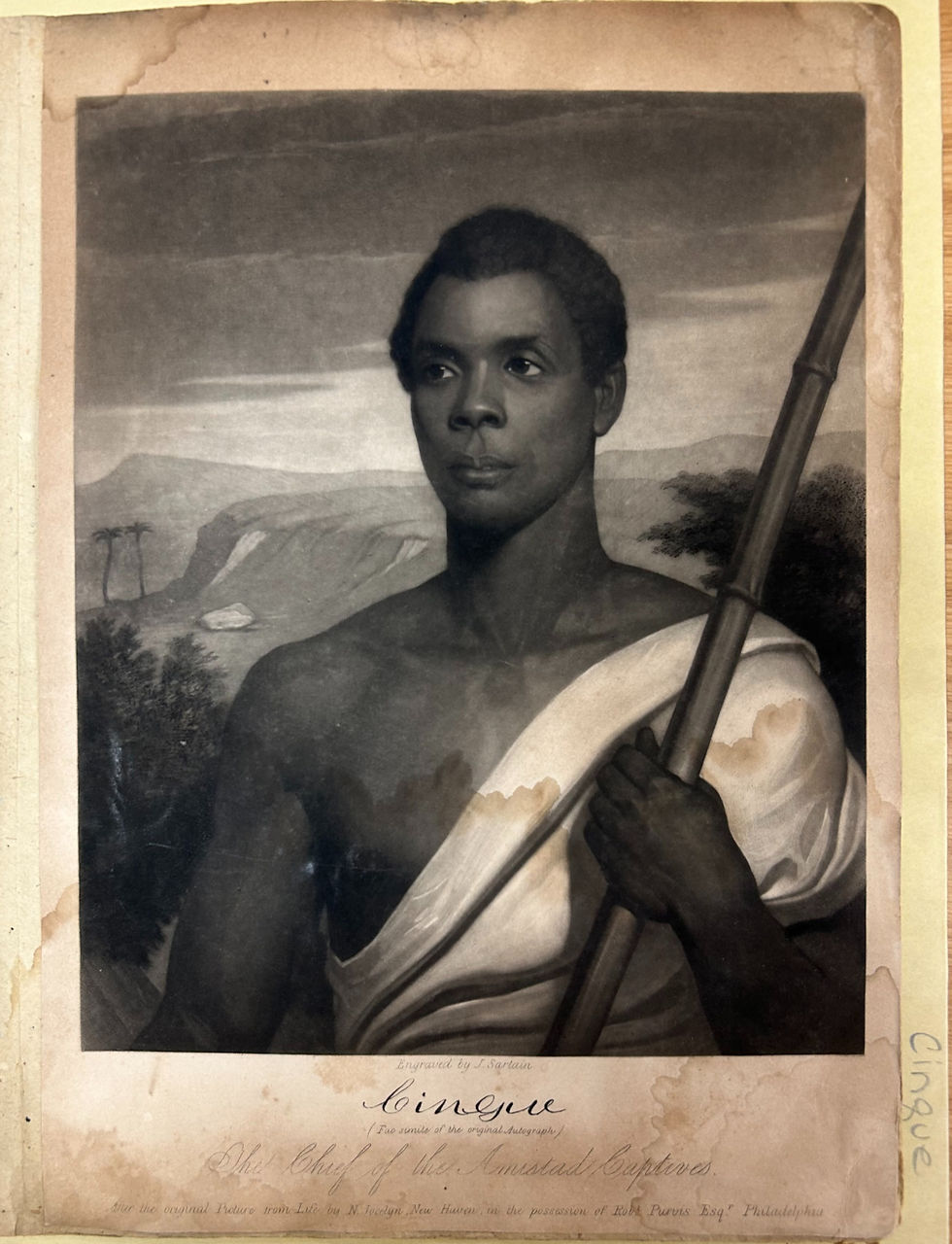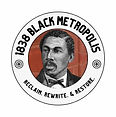The Picture That Freed Hundreds: Madison Washington's Cinque Inspiration at 918 Lombard Street
- 1838 Black Metropolis
- Oct 27
- 6 min read
Updated: Oct 30
Sometimes we stumble upon incredible stories from the past and this was one was soooo good, we had to bring it to you in it's unadulterated format. It's a story of a deeply felt inspiration; one that led to the liberation of hundreds...inspired by the viewing of a portrait at 918 Lombard Street. It's the story of how one successful slave ship uprising encouraged another. And it's a story about how Black Philadelphia supported and grew worldwide liberation in the mid-1800s.
Background
This is a portrait of Cinque. In 1839, Cinque led a successful rebellion on the slave ship The Amistad. However, a trial ensued where the freedom of the Africans on the boat was contested. They won their case and were sent back to their home. There's a whole movie about it.

Philadelphian Robert Purvis was living at 918 Lombard, using his home as both an Underground Railroad stop and headquarters for the Vigilance Committee, which was leading arrival support - food, transportation, shelter - for formerly enslaved people who had self-liberated with the support of the Underground Railroad.

First, We Have This Portrait Because of Robert Purvis
Purvis was so inspired by Cinque that he hired artists to go to Cinque and capture his portrait.
Second, The Picture Freed Hundreds And Caused an Artists Revolt at PAFA in 1840
But what happened because of this portrait is what we are really talking about today.
This incredible story is straight from the recollections of Robert Purvis. We are reprinting a portion of this Philadelphia Inquirer article from December 26, 1889 so you can hear it straight from Purvis himself.
In Purvis' Words
-----------------------------------------------------------------------------------------
BEGIN REPRINT
_________________________________________________________________________

INSPIRED BY SINQUE'S EXAMPLE
"Now comes the strange part of the story.
I was at that time in charge of the work of assisting fugitive slaves to escape. Among the slaves who came into my keeping in this way was a man nated Madison Washington. We sent him to Canada, but, to my astonishment, on the day that I received this painting Washington returned and came to my house and asked me to help him secure the release of his wife, who he had left in slavery two years earlier with a young white man in the South, whom he trusted implicitly and who had promised to bring his wife from the plantation during the Christmas holidays and deliver her to Washington at a certain spot where they were to meet.

I showed Washington this painting and he asked me who it represented. I told him the story of Singue, and he became intensely interested. He drank in every word and greatly admired the hero's courage and intelligence. Well, Washington went South and never came back. How he was betrayed or who it was that betrayed him I never knew until some years later, when I learned that he was captured while escaping with his wife, and put on board a vessel bound from Virginia to New Orleans.
LORD PALMERSTON'S BRAVE WORDS
During the voyage Madison Washington, inspired by the example of Sinque, secured his release, killed the captain, freed the other slaves, numbering about two hundred, and compelled the mate to navigate the vessel into English waters. He landed them at Nassau, English province. At the instance of the South, this Government demanded from Great Britain the immediate return of these slaves as murderers and as property. The authorities of Nassau refused to send them back, but detained them by putting them in prison, and referred the matter to the home government.

Lord Palmerston was then Prime Minister of England, and he settled the question then and forever by replying that 'England knows of no act, even to the taking of life, that can be construed as a crime, when committed in pursuit of the natural and inalienable right of freedom.' The United States recognized the justice of this decision, and never pushed its claim.
And all this grew out of the inspiration caused by Madison Washington's sight of this little picture.
EXHIBITED AT THE ACADEMY
But that is not all that this painting has accomplished. One more little story and I am done. I had the picture engraved by John Sartain, who had just originated the mezzotint engraving process.. Mr. Sartain was much interested in the painting, and he asked that it be sent to the Academy of the Fine Arts, of which he and the painter, Mr. Joelyn, were members.

The picture was sent, and within the next twenty-four hours I received a letter from Mr. Nagle, of the managers, stating that pictures of that character could not be placed on the walls of the Academy. This offended Mr. Sartain, Mr. Jocelyn and other members who the sympathized with them, and they seceded from the academy. A bitter fight followed between the managers and seceders, which finally resulted in victory for the latter. They returned to the Academy, when the managers finally yielded and placed the picture on the walls of that institution. Their principal objection to the painting was that its subject was a hero, and they considered that a black man had no right to be a hero.
Such is the history of the painting of Sinque, the Hero of the Amistad,' concluded Mr. Purvis. 'It only cost me two hundred and sixty odd dollars, but I would not part with it now for that many thousands. In fact, it is priceless.'"
________________________________________________________________________
END REPRINT
________________________________________________________________________
Closing thoughts
Underground Railroad Headquarters
Directly across the street from Robert Purvis was the home of Stephen Smith. Smith was a wealthy community leader who famously owned railcars with hidden compartments. He would transport people who escaped plantations in these compartments from Columbia, PA to Philadelphia. This was an above ground underground railroad.

During 1841, these two men were living right across from each other. With the meeting place of the Vigilance Committee across the street from Smith, who had the means to fund the movement, this means that the corner of S. Fothergill (Now S. Hutchison) and Lombard could have been the HQ of Liberation in the late 1830s and early 1840s.
What It Must Have Felt Like
Imagine that you have just come in from an arduous journey on the Underground Railroad. All you've known is terror and work and sorrow and oppression.
Then suddenly you stand in the well appointed parlour of a Black family home in Philadelphia. And on the wall...a beautiful portrait of a dignified and proud African man.
What did that feel like? How did that impact your soul? This was the experience of hundreds of people at 918 Lombard and we tell this story so that the reverberations of joy and liberation can reach all of us today.
The Black Metropolis Nourished Black Liberation Worldwide
Madison Washington's actions, given the moniker 'The Creole Affair', galvanized the world. The UK and US almost went to war over it. Multiple books have been written about it. Including Frederick Douglass' only novel 'The Heroic Slave', based on Washington's actions.

All of this because of the foresight and action of Black Philadelphia's liberation leadership.
Our Academic Director Dr. Kirstin Lee encourages us that It's important to remember that this story about Cinque's portrait at Purvis's home is also a story about Black internationalism.
When we revisit this story we are reminded that Philadelphia nourished world-famous, internationally significant Black revolutionaries on blocks we walk every day. We are reminded that Black revolutionaries came to this city and received encouragement, support, protection, and celebration by Black Philadelphia. We are reminded that the Black Metropolis is world-famous for its hospitality towards Black people of all origins, statuses, nationalities, and traditions. ~ Dr. Kirsten Lee
Sources
Cinque Folder, William H. Dorsey Manuscript Collection, Cheyney University Special Collection
The Philadelphia Inquirer, Philadelphia, Pennsylvania · Thursday, December 26, 1889
Bacon, M. H. (2007). But one race : the life of Robert Purvis. State University of New York Press. Bacon describes the sale of the house on Lombard in Chapter 3. We examined the historical index and found deed AM 26 469. This deed states that the house was 180 feet west of ninth on Lombard. Evaluating the measurement against the 1860 Hexamer and Locher map indicates 918 Lombard as the house number.




